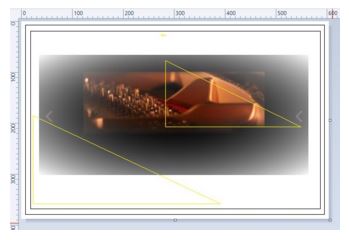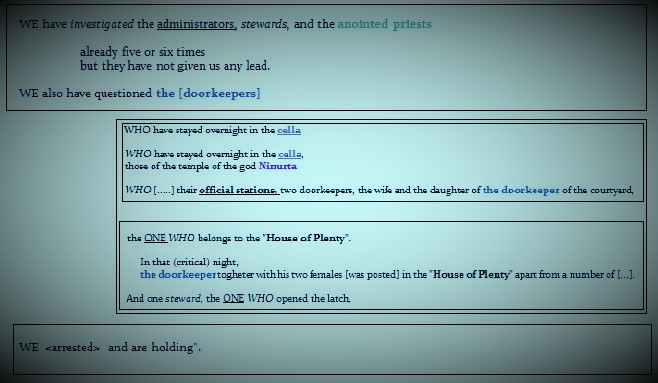
Mediterranea
A Journal of Cultural Anthropology and Ethnomusicology
( 1 /2017)
Monumenta
Dotium
Semiticarum

Le Law-Letters
di Sa-am-su-iluna

Studi preliminari
L.W. King, Letters and Inscriptions of Ḫammurabi, (Vol. III , London, Luzac and Company 1900).
https://archive.org/stream/cu31924104781285#page/n199/mode/2up
Publications of the Babylonian Section, Volume 1, Issue 2
Amazon.it: University of Pennsylvania University M.
Karen Radner, State Correspondence in the Ancient World
https://books.google.it/books?isbn=0199354774
Anson F. Rainey-William M. Schniedewind-Zipora Cochavi-Rainey, The El-Amarna Correspondence (2 vol.)
https://books.google.it/books?isbn=9004281541
A. Leo Oppenheim, Letters From Mesopotamia: Official, Business, and Private Letters
http://oi.uchicago.edu/research/publications/misc/letters-mesopotamia-official-business-and-private-letters-clay-tablets
Daniel David Luckenbill, Ancient Records of Assyria and Babylonia Volume 2
http://oi.uchicago.edu/research/publications/misc/ancient-records-assyria-and-babylonia-volume-2-historical-records-assyria

Police Humour
La fonte 7217 in PBS 1/2 e il genere delle Law Letters di Samsuiluna.
Analisi retorico-strutturale e tipologica. Sintesi antropologico-culturale
di Davide Polovineo
01 /22 / 2016
"Ecco appunto la tinta che noi cercavamo....."
Dai "Racconti di Sherlock Holmes" :
la "Lega dei Rouquins di Arthur Conan Doyle
1 The Policemen on his tracks: opening
"In like manner Samsu-iluna in the intervals of directing state affairs occupied himself in settling a dispute between fishermen from rival villages ecc... It is quiete clear that at this period the Babylonians lived after an exceedingly primitive fashion, and that their pursuits were chiefly pastoral and agricultural; their religious Ideas and beliefs were, of course, characteristic of the grade of civilization to which they had attained". Con questa lapidaria osservazione, L.W. King nella prefazione delle Letters and Inscriptions of Ḫammurabi, (Vol. III , London, Luzac and Company 1900 Pref. XI) introduce nella scena dello scorso secolo la figura di Sa-am-su-iluna, (cfr. per l'annalistica Chronicles of Kings of Babylon Sa-am-su-iluna LUGAL-E: Brit. Mus. 22,507 and 91, 083, pl. 199ff, Nos. 98 and 99; cfr. L.W. King p.241).
L'analitica della fonte in PBS 1/2 12 [Letter of Samsu-iluna, the King and successor of Ḫammurabi, to "the bêl teritim ù šatamme" ( N° 7217 Pennsylvania University Museum Meas. 105 x 54 x 25; brown; slightly baked. Insc. 17 (obv) 2 (Lo.E.) 15 (Rev.)= 34 li.] si collega con la fruttuosa osservazione di L.W. King che con le sue "dichiarazioni" simbolicamente ci introduce nella House of Plenty (= storehouse: cfr. nakamtu in Brit. Mus. No. 13, 936 pl. 84 N0. 49 nakamtu ša bit Šamaš: cfr. anche Brit. Mus. No. 23,122 ; pl. 49; No.29; Brit.Mus. No. 23, 148; pl. 66; No.39) location del "plot" occultamente celato nella fonte epistolare.
Nella Law-Letter è assente (cfr. anche PBS 1/2- 13; cfr. in The Letters and Inscriptions of Hammurabi, ed. L.W.KING, Vol III, London, Luzac and Company 1900: Bu. 91-5-9, 606; pl. 133 No 81; Brit. Mus. No. 13.936; pl. 84 No. 49;Brit. Mus. No. 27.269; pl. 151 No. 80; Brit. Mus. No. 27, 268; pl. 149 No. 79; Brit. Mus. No. 86.287; pl. 237 No. 104) il consueto "Opening- Saluto" [liba li-duka (cfr. PBS 1/2-4) oppure liba al-li-iṭ-ka(cfr. PBS 1/2-2) oppure a-na di-na-an be-li-ia lu-lul-lik (cfr. PBS 1/2 80)] e il "Tell" (a-na) della epistola, risposta ad una missiva precedente inviata dagli amministratori e dagli ufficiali governativi di Sa-am-su-iluna, svela la vicenda e il ruolo di "attante-mediatore" del re (cfr. per il ruolo del Re-mediatore, L. T.DARLING, History of Social Justice and Political Power in the Middle East: The Circle of justice from Mesopotamia to globalization, Routledge, London-New York 2013, p.22). La stessa Iscrizione di Sa-am-su-iluna (Sumerian Version: Brit. Mus. No. 22.507 e 91.803 pl. 199 ff., Nos.98 e 99) rivelando il ruolo di Shepherd King- rēʼu [cfr. il celeberrimo "biglietto da visita" di Sa-am-su-iluna: "....Then Marduk, the Lord of his Land, who is endowed with wisdom, unto me, Samsu-iluna, the king of his abundance, granted the whole of the world to rule, and with majesty he commanded me to settle his own land in security, and to rule the scattered peoples in prosperity for ever" (Brit. Mus. No. 22.507)], ci permette di comprendere l'intelligente azione politica di Sa-am-su-iluna e le sue mediazioni politico-amministrative (LU-GAL LA-LA-NI NI-ME-EN-NA-T[A]...). Da un punto di vista di Redaktion-Kritik del Tablet-Record PBS 1.2 12, il leit motiv del Re-mediatore+Royal courts of Justice "ri-colloca" la fonte nel Sitz im Leben delle grandi riforme socio-religiose di Eannatum e di UruKAgina. Eleganti social-planners di Umma e Lagash, le riforme regolavano in uno stile austero e sacrale, il "Ritual-Time-Work" e le Law-Time-Words del regale Plot-Service e Spot-Market degli amministratori.
2 The Sherlockian-King: analisi tipologica
Solitamente nella struttura delle Law-Investigation-Letters (Order for Investigation) di Ḫa-ammu-rabi/Sa-am-su-iluna (cfr. i modelli idealtypici in Brit. Mus. No 12.846; pl 32, No. 19; Brit. Mus. No 86,284; pl. 235, No. 103; Brit. Mus. No. 12,829; pl. 18; No. 11) è presente un Tell (a-na)+ ki-bi-ma senza saluto protocollare. Il corpus della lettera in PBS 1/2 12, conservante i caratteri stilistici di Ḫammu-rabi, è strutturato nel seguente modo: Opening - Verbale - Ordine:
Tell the officials and administrators: King Samsuiluna sends the following message: You have answered to what had been written to you concerning an investigation about the silver and the gold that was taken from the (storehouse called) "House-of- Plenty" and concerning the checking on what had disappeared, as follows: " We have invetigated the administrators, stewards, and the anointed priests already five or six times but they have not given us any lead. We also have questioned the [doorkeepers] who have stayed overnight in the cella [and the...] who have stayed overnight in the cella, those of the temple of the god Ninurta who >scribe forgot: abandoned> their official stations, two doorkeepers, the wife and the daughter of the doorkeeper of the courtyard, the one who belongs to the "House of Plenty". In that (critical) night, the doorkeeper togheter with his two females [was posted] in the "House of Plenty" apart from a number of [...]. And one steward, the one who opened the latch, we and are holding". This is what you wrote me. Now when you have read this tablet of mine, Lu- Ninurta, you yourselves, and the administrators [and] anointed priests should take the doorkeepers and the one steward and also the officials who have not been at their official stations and come here to Babylon. [The judges] need not come here, they should make a decision only in the case which I have assigned to them.(trad. in A. Leo OPPENHEIM, Letters from Mesopotamia, The University of Chicago Press, Chicago 1967, pp.88-91).
Probabilmente il modello della Law-Investigation-Letter di Sa-am-su-iluna in PBS 1/2 12 deve essere associato al modello Order for Trial [cfr. ad esempio Brit. Mus. No. 12,815; pl. 3. No. 2; cfr. anche amēlu ši-i-bi ša i-ga-ab-bu-ḳu / a-na ma-aḫ-ri-ia tu-ur-dam (Brit. Mus. No. 12,815; pl. 3. No. 2, Rev. 12-15)]. E' necessario anche il confronto con lo stile letterario "tell rabiānu" o "ṣāb bāb eḳalli"; anche la Law Letter PBS 1/2 12 è caratterizzata da costruzioni con il verbo parašu [( cfr. to investigate; to decide; warkarta parašu: "to examine into a matter; to investigate a cause of dispute" (king, pp. 286, 287) for the investigation of a case: pu-ru-uš warkātu / wa-ar-ka-as-su pu-ru) Brit. Mus. No. 12,829; pl. 18; No. 11; Brit. Mus. No 86,284; pl. 235, No. 103; Brit. Mus. No 12.846; pl 32, No. 19 cfr. anche li-ip-pa-ri [š]- to be investigated Brit. Mus. No 27,254; pl. 175; No.91].
Similmente allo stile ḫammurabiano, la fonte in PBS 1/2 12 presenta un carattere letterario, sobrio ed elegante, richiamante anche la "modulistica protocollare contract-tablets". Dalla semplice lettura delle fonti comparate si può comprendere la difficilissima e affascinante situazione storica (cfr. Brit. Mus. No 17, 269; pl. 151; No. 80: Directions for the strict observance of fishing rights).
3 Composizione retorico-strutturale
Composizione e interpretazione del "Verbale" contenuto nella lettera
La parte è formata, solidamente, da quattro graziosi brani in figura di chiasmo (A B B1 A1). Adorno di grazia formale, il brano A è composto da un segmento monistico ( We have..), da un segmento distico e da un segmento monistico ( We also have..). La struttura del brano è ABA. Il brano B è formato da un segmento monistico ( Who have), da un segmento distico ( Who have) e da un segmento monistico ( Who... their). La struttura è A A1 A2 (parallelismo con Who). Il lessema cella è presente in A A1.Il Brano B1 è formato da un segmento monistico ( One Who) , da un segmento distico e da un segmento monistico (One Who). La struttura del Brano è ABA. L'associazione lessicale House of Plenty è presente in A B. A 1 è un segmento monistico [We arrested.. cfr. anche e-si-ir-ma ( da esēru = to enclose; to arrest) in Brit. Mus. No 27,268; pl. 149, No.79 ]. Il lessema doorkeeper è presente nei brani A-B-B1.
Consecutio temporum=le forme verbali tendono alla linea temporale remota.
Attanti: administrators, stewards, priests, doorkeepers+ the wife and the daughter of doorkeepers.
Location e set dell'indagine di polizia: Cella + Temple of the God Ninurta- House of Plenty.
I parallelismi illuminano la cospirazione formale-epistolare [cfr. Bu. 91-5-9; pl.153; No. 81: parallelismo a-na*Sippar-ki*edin-na (5.10); Brit. Mus. No. 13,936; pl. 84, No. 49: še-am*a-na (6.12); Brit. Mus. No. 27, 269; pl. 151; No. 80: a-na*ugar* Ra-bi-i-im *u* u-gar* Ša-am-ka-nim (6-7. 16-17. 22-23) elippē*ba᾿irūti (8.15.21)].
Il verbale, contenuto nella lettera, è di estrema importanza da un punto di vista retorico-strutturale. Per una maggiore comprensione, strutturiamo il testo tradotto in inglese:

Da un punto di vista stilistico, nella Law-Invetigation Letter in PBS 1/2 12 sono presenti costruzioni sintattiche "roughly elder speak". Probabilmente esisteva un prontuario elaborato dalla scuola degli scribi (vade-mecum idealtypico per la comunicazione o informativa di notizia di reato): "The writing found upon early Babylonian letters- afferma King- is of cursive character, and though many of the signs retain in some degree the complicated forms of the Sumerian period, it is evident that they were written rapidly. In order to keep his rows of characters level the scribe ruled with his stilus a number of horizontal lines across the tablet, and when writing he impressed the heads of his characters upon the ruled line above them. No king appears to have employed more than one scribe for writing his letters and despatches, for all of Ḫammurabi's letters are in the same bold hand, whilst those of Abēšu' are in rather smaller but quite distinctive character. The style of composition employed in the letters is somewhat brief and abrupt, and forms a striking contrast to the verbose phraseology of the letters from Tell el-Amarna. This may be explained by the fact that they are not diplomatic communications but the letters of kings to their subordinate officers containing their commands or requests form information. A king, naturally, wasted no time in paying empty compliments to his subordinates. ( King, op.cit., Preface pp. XXIII-XXIV).
4 Police Humour: sintesi antropologico-culturale
"Di mano in mano che la notte si faceva più profonda,
più profondo diveniva in me l'interesse per quello spettacolo".
(Edgar Allan Poe, dall'Uomo della Folla)
Con l'operazione metodologica "Strand versus structure" degli schemi comparativi [verbale dell'amministrazione reale di sa-am su-iluna e verbale idealtypico contemporaneo (comunicazione o informativa di notizia di reato)] idealtypicamente delineo la seguente struttura (cfr. per una prospettiva metodologica EICHINGER FERRO LUZZI G., Strand versus structure in the Theory of myth, in "Anthropos" 78 (1983) 437-458):
1) Fatto-reato addebitato
2) Luogo, giorno e ora dell'acquisione della notizia di reato
3) Persona sottoposta alle indagine
4) Persona offesa
5) Persone in grado di riferire circostanze rilevanti
6) Attività d'indagine compiuta
Inoltre in base all'analitica di L. T.DARLING (History of Social Justice and Political Power in the Middle East: The Circle of justice from Mesopotamia to globalization) dalla Law Investigation Letter in PBS 1/2 12, fonte comparabile con gli Orders of Trial analizzati, possiamo, ipoteticamente, ricostruire la struttura del procedimento penale, occultamente presente nella fonte, della Royal Justice Administration diSa-am-su-iluna per la tutela giuridizionale dei diritti:
1) Ordine di apertura del procedimento da parte del reggente: probabilmente i supremi comandanti te-ri-(e)tim convocavano il giudice daiânê (probabilmente con ruolo simile all'attante sumerico DIKUD cfr.Bu 88-5-12; pl.130, No.69).
2) Il Giudice avvia la raccolta delle prove con i rabiānu ( cfr. anche i titoli ṣāb bāb eḳalli in Brit. Mus. 86,284; pl. 235, No. 103 e inoltre il titolo muzzaz bābi in Brit. Mus. No. 27, 268; pl. 149; No.79).
3) Introduzione della causa: formule con costruzioni con il verbo parašu.
4) Istruzione della causa-udienze e acquisizione delle prove (onere probatorio): formula amēlu ši-i-bi ša i-ga-ab-bu-ḳu / a-na ma-aḫ-ri-ia tu-ur-dam.
5) Discussione: kīma ṣimdat šarri.
6) Decisione-Verdetto da parte del giudice. Si poteva richiedere il giudizio diretto del reggente (cfr. Brit. Mus. No 12,815; pl. 3 No. 2): cfr. formula a-na ma-aḫ-ri-ia: "The king himself- afferma King - was of easy access to his subjects, and applicants for justice frequently applied to him at Babylon before presenting petitions to their local courts. Thus in Nos. IX, XIII and XVI we find plaintiffs appealing to the king direct, and in No, XII a plaintiff who has so appealed is described as a man of Nippur. These letters, like Nos. X, XI and XIV also illustrate the supervision which Ḫammurabi exercised over cases tried at Larsam; not only did the king send cases to Sin-idinnam for trial, but he frequently made an examination of the case himself and suggested the verdict which should be given" (KING, ivi, cit. p. 41).

|